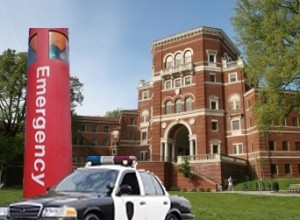
A new classroom product that combines sound amplification, lecture capture, and emergency alert capabilities in a single system could have a big impact on the safety of K-12 and higher-education classrooms.
The Safe Security system, from Panasonic and Audio Enhancement, features a button on a microphone worn around the instructor’s neck that, when pressed, sends a silent alarm to a school’s central offices and to administrators. Once alerted, school leaders have access to a live video feed courtesy of a networked camera inside the classroom, as well as to the audio feed captured on the microphone, and they can immediately assess what type of emergency is occurring in the classroom.
Jeff Anderson, president of Audio Enhancement, said many teachers wear wireless microphones around their necks as part of standard classroom audio systems, and incorporating a built-in security alert system was a logical next step.
If there is an incident in the classroom–an attacker, a medical emergency, or whatever–all a teacher must do is hold down a button on the audio transmitter for two seconds. Three blue lights will appear on the transmitter to let the instructor know that the alarm has been activated.
Activating the alarm sends an eMail message to any number of designated school employees, and the message would make a unique sound on administrators’ smart phones. Schools also can install a siren strobe in their main administrative offices, which will light up to tell designated employees to check their eMail for an alert. The emergency eMail message contains a link that, once clicked, takes administrators to the live audio and video feed from the classroom.
“Going past the basic [classroom audio and security functions], schools can also program the camera for distance learning,” Anderson said. “I believe education is going to move that way.”
The Safe System can shorten the amount of time it takes first responders to appear or react, he added.
The MS1000, the system’s monitoring console, runs on a network that is independent from a school’s eMail server, which Anderson said is an effort to keep the system running quickly, because school eMail servers can become bogged down.
“Administrators and first responders [should] know what they need to be prepared for and if they should even enter the room,” Anderson said, calling the combined solution “a
game-changer; … something education hasn’t seen, and something education wants.”
Bob Fortenberry, a former school district superintendent, said safety is one of several benefits the system offers. Fortenberry spent 17 years as superintendent of Jackson Public Schools in Jackson, Miss., before becoming a private-sector educational consultant.
“It’s extremely important for students to learn and for several other things to occur in a classroom, and safety is one of those,” he said. “This system, I think, [adds the ability] to see what’s occurring in the classroom and respond immediately to problems that would threaten safety. It would be very beneficial.”
Most U.S. schools are safe places, Fortenberry was careful to point out–“but there do arise occasions where that’s not the case.”
Beyond safety, there also is a need to see what is occurring in classrooms and capture that for various reasons, Fortenberry said–primarily for staff development purposes. And the Safe System can aid in that pursuit.
“Teachers need a lot of help, and one form of help is from people who can observe what’s occurring, can help teachers improve professional practice, and [can] see which students are and aren’t engaged, because one significant aspect of student learning is keeping students engaged,” he said.
In addition, the system could be used as a lecture-capture system; schools could post the audio and video from a classroom session online to help students who were absent from class or who want a chance for further review, Fortenberry said.
The Safe System is being marketed to both K-12 and higher-education institutions–and there might be an even greater need for it in higher education, Anderson said.
Professors who keep students in locked classrooms during reports of a campus shooter, for example, would have an immediate way to contact university officials without having to worry about cell-phone reception and other obstacles.
Links:
- A look at AI use in schools across the country - November 18, 2024
- 5 ways your classroom environment boosts student engagement - November 14, 2024
- Federal toolkit targets safe, ethical AI use in classrooms - November 11, 2024


